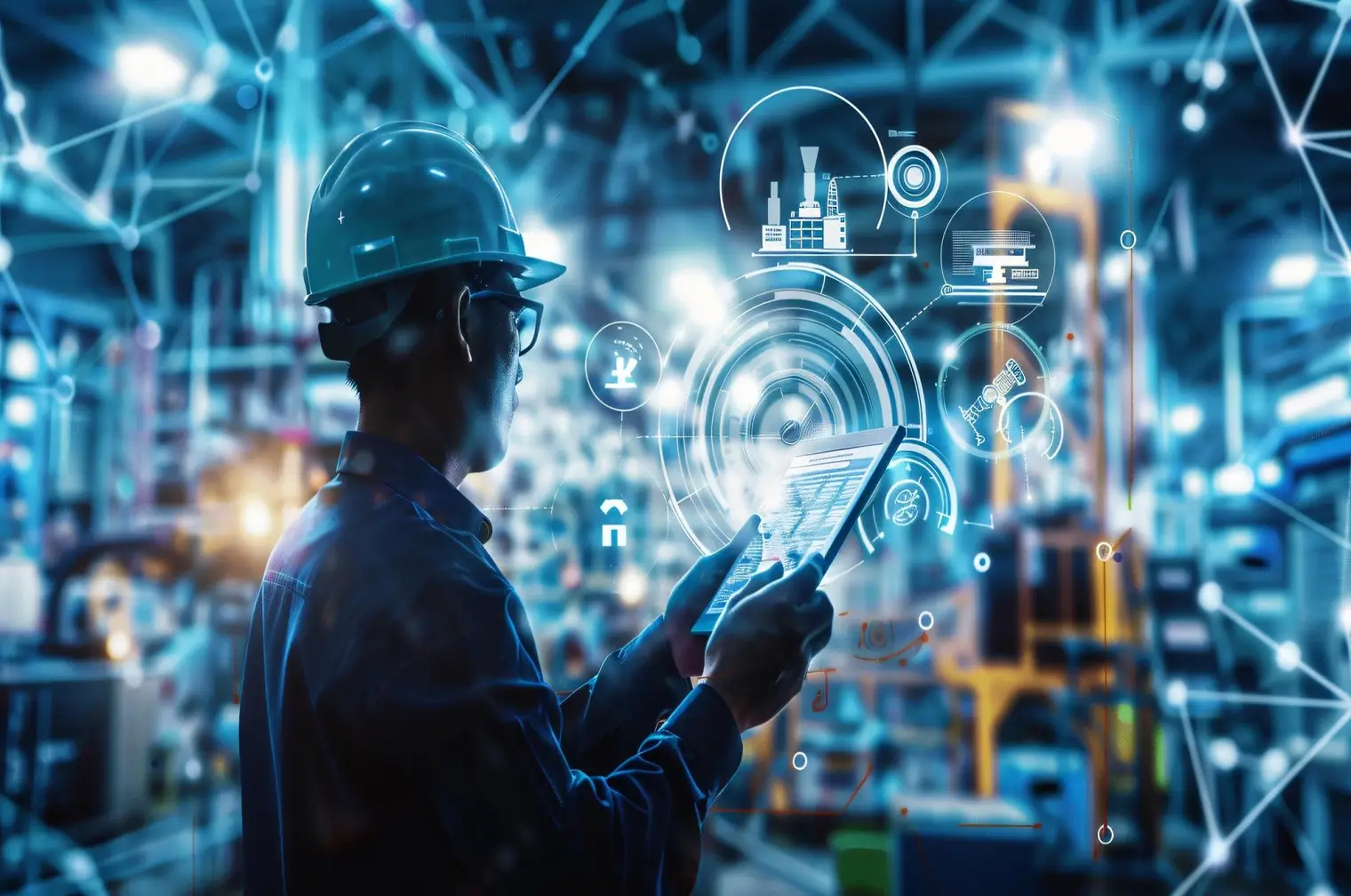Machine Learning and AI for revolution of Tech Companies are changing and streamlining businesses.
The integration of AI in energy is revolutionizing the way businesses approach equipment maintenance. At ViitorCloud, we offer cutting-edge AI solutions in energy that are designed to enhance operational efficiency and reduce costs. With predictive maintenance becoming increasingly sophisticated, our AI development services enable organizations to leverage predictive analytics for optimizing operations and extending equipment lifespan.
The global predictive maintenance market is projected to grow from USD 10.6 billion in 2024 to USD 47.8 billion in 2029, at a CAGR of 35.1% during the forecast period. ViitorCloud stands at the forefront of this transformation, providing tailored AI solutions that address the unique challenges faced by the energy sector. Our expert team collaborates closely with clients to develop innovative strategies that not only meet immediate needs but also align with long-term business goals.
What Is Predictive Maintenance?
Predictive maintenance is a proactive approach that leverages data analysis tools and techniques to identify potential equipment issues before they escalate into failures. Unlike traditional preventive maintenance, which is based on scheduled inspections, predictive maintenance harnesses real-time data to forecast the optimal timing for maintenance tasks. This strategy is particularly crucial in the energy and utilities sector, where the integration of AI in energy is transforming how we manage critical assets like turbines, transformers, and pipelines.
Even minor equipment failures can lead to significant outages and substantial revenue losses, making it essential to stay ahead of potential problems. By adopting predictive maintenance, energy companies can enhance reliability and efficiency, ultimately safeguarding their operations and bottom line.
Unlock Your Energy Potential
Discover how AI can transform your predictive maintenance strategy.
How AI Enhances Predictive Maintenance in the Energy Sector
1. AI-Powered Data Collection and Analysis
The integration of AI in energy has revolutionized predictive maintenance by streamlining data collection and analysis. In the past, monitoring equipment relied heavily on manual analysis of sensor data, which often led to missed insights. Today, AI systems can swiftly process massive datasets in real time, uncovering patterns that might elude human observers. This capability is particularly vital in the energy sector, where even minor deviations in equipment performance can signal significant issues.
By leveraging AI-driven predictive analytics for continuous equipment monitoring, energy companies can minimize downtime, prolong machinery lifespan, and enhance overall operational efficiency. For instance, machine learning algorithms can scrutinize vibration patterns in wind turbines, allowing companies to anticipate mechanical wear before it escalates into a major concern. This proactive approach not only safeguards assets but also fosters a more reliable energy supply for everyone.
2. Real-Time Monitoring and Alerts
The integration of AI in energy systems is transforming how companies track and enhance equipment performance. With the capability for real-time monitoring, AI technologies can alert technicians when the risk of a breakdown rises. This proactive approach allows for maintenance to be performed exactly when necessary, eliminating the need for disruptive scheduled downtimes.
Take, for example, power grids that utilize AI to assess the condition of vital components such as transformers. By analyzing data in real-time, AI delivers instant feedback, facilitating timely repairs or adjustments. This shift towards predictive maintenance not only helps avoid expensive breakdowns but also boosts the efficiency of energy distribution. Embracing AI in energy systems is not just a trend; it’s a smart strategy for maintaining operational excellence and reliability.
3. AI and Digital Twins in Predictive Maintenance
One of the most thrilling advancements in AI technology for predictive maintenance is the integration of AI in energy through the use of digital twins. A digital twin serves as a virtual counterpart to physical equipment, leveraging real-time data to simulate, predict, and enhance performance. In the energy sector, these AI-driven digital twins offer valuable insights into how assets respond under different conditions.
Energy companies are increasingly adopting AI-based digital twins to model the effects of various stressors on their equipment. By running these simulations, they can accurately forecast how equipment will age over time, allowing for more effective maintenance scheduling. This innovative technology not only boosts operational efficiency but also significantly lowers maintenance costs, making it a game-changer in the industry.
Benefits of Integration of AI in Energy for Predictive Maintenance
1. Reduced Downtime and Maintenance Costs
One of the primary advantages of using AI in energy for predictive maintenance is the reduction in downtime. Unplanned outages can be costly, not only in terms of repairs but also due to the loss of production. AI’s ability to predict equipment failures allows energy companies to schedule maintenance during off-peak hours, minimizing the impact on operations.
Additionally, AI technology helps companies reduce maintenance costs by ensuring that repairs are only performed when necessary. This targeted approach prevents unnecessary maintenance and extends the lifespan of expensive equipment, leading to significant cost savings over time.
2. Improved Safety and Reliability
Safety is a critical concern in the energy sector, and predictive maintenance using AI greatly enhances workplace safety. By predicting equipment failures before they happen, energy companies can prevent accidents and ensure the safety of their workers. For example, in oil and gas operations, AI-driven predictive analytics can detect irregularities in pipelines, preventing potential leaks or explosions.
Moreover, AI improves the overall reliability of energy systems by ensuring that equipment operates at peak performance. Reliable equipment means fewer outages and more consistent energy delivery, which is especially important as renewable energy sources like wind and solar become more integrated into the grid.
3. Sustainability and Environmental Impact
AI-powered predictive maintenance also contributes to sustainability efforts within the energy and utilities industry. Efficient equipment operation means less energy waste, which directly translates to lower carbon emissions. For instance, by predicting when a wind turbine’s components will wear out, companies can replace them before they cause efficiency losses. This proactive maintenance ensures optimal energy production, reducing waste and improving the overall sustainability of energy operations.
Furthermore, AI in energy supports the integration of renewable energy sources by improving the reliability of the grid. With AI’s ability to predict and manage the fluctuating power generation from renewable sources, the energy industry can more confidently rely on clean energy, reducing its dependence on fossil fuels.
Stay Ahead of Equipment Failures
Learn more about our tailored AI solutions for the energy sector.
How Are Energy Companies Implementing AI in Predictive Maintenance?
1. AI-Driven Predictive Analytics in Power Plants
Many power plants have already begun integrating AI for predictive maintenance. AI systems in these plants monitor equipment like turbines, boilers, and generators to detect signs of wear or inefficiencies. By analyzing historical data and real-time information, AI can predict when a component is likely to fail, allowing technicians to address issues before they become critical.
For instance, General Electric (GE) uses AI technology in its power plants to monitor turbine performance and predict when maintenance is necessary. This system has led to improved operational efficiency and a reduction in unplanned outages, saving millions of dollars annually.
2. AI in Renewable Energy Management
The renewable energy sector is also benefiting from AI-driven predictive maintenance. Wind and solar farms, for example, use AI to monitor the performance of turbines and solar panels, ensuring that these assets operate at maximum efficiency. AI-powered drones and sensors can also perform visual inspections, identifying potential issues that might not be detected during routine maintenance checks.
This technology allows renewable energy companies to schedule maintenance only when necessary, reducing costs and downtime while ensuring that green energy sources remain productive.
What Are the Challenges of Implementing AI in Predictive Maintenance?
While the integration of AI in energy offers numerous advantages, it also presents several challenges that must be addressed. One significant hurdle is the substantial initial investment required for AI systems and sensors. Smaller energy companies may struggle to justify this cost, even though the long-term savings from AI can be considerable.
Moreover, the effectiveness of AI technology hinges on having access to accurate and comprehensive data. If the data quality is lacking, AI systems may struggle to deliver precise predictions, which can result in suboptimal maintenance strategies.
Another critical factor is the need for workforce adaptation. The energy and utilities sector must prioritize training employees to effectively utilize AI systems. This training should encompass not only the technical aspects of these tools but also the skills needed to analyze and interpret the data they produce. By addressing these challenges head-on, companies can fully harness the potential of AI in predictive maintenance and drive significant improvements in their operations.
Optimize Your Operations Today
Join the revolution in predictive maintenance and enhance your efficiency.
Conclusion
The integration of AI in energy is transforming predictive maintenance, offering energy companies the tools to minimize downtime, reduce costs, and enhance safety. Through AI-powered predictive analytics, real-time monitoring, and digital twin technology, you can anticipate equipment issues before they occur and streamline your operations. As AI advances, these solutions will play an even more crucial role in making energy systems more reliable and sustainable.
Harness the power of AI solutions in energy. ViitorCloud’s AI development services are tailored to elevate your predictive maintenance strategy and future-proof your business. Partner with us and optimize your energy operations today! You can also send us a message on LinkedIn, and we will respond as soon as possible.
Frequently Asked Questions
ViitorCloud offers AI-driven predictive maintenance solutions that analyze real-time data from your energy assets to predict equipment failures. We help you minimize downtime, reduce operational costs, and improve the reliability of your infrastructure.
We use advanced AI technologies, including machine learning, predictive analytics, and digital twins, to monitor and predict the performance of critical energy assets, ensuring timely and efficient maintenance actions.
Yes, our AI solutions are fully customizable to meet the specific needs of your energy operations, whether you’re managing turbines, pipelines, or transformers.
ViitorCloud integrates AI-powered sensors and software into your existing systems without requiring a complete overhaul, ensuring a smooth and cost-effective transition to AI-driven predictive maintenance.









